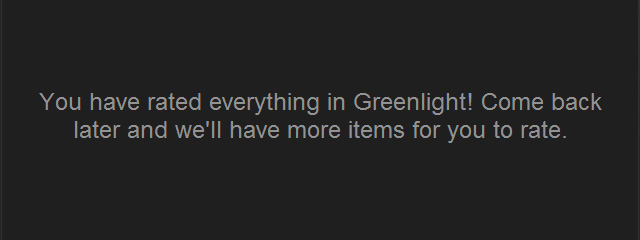
I’m one of those people, who check all the games on Steam Greenlight when they can. There’s always a chance to stumble upon some really cool game you might like or a project which you might not like and would probably not buy, but still support by saying “yes” just because it looks cool. And while the service itself is far from perfect, a fact acknowledged by Valve themselves, it makes it easier for a lot of independent developers to get on Steam, the service which tends to help the game sales immeasurably. So let’s leave the imperfections of the service itself to Valve to fix, while I want to name two big things developers themselves should consider, while trying to Greenlight a game, from the viewpoint of a person who’s making the votes.
Don’t go there too early. I’ve seen numerous games on Greenlight which are in a very-very early stage of development or even the concept stage. There is a special section for Concepts on Greenlight now, but even with it you should always understand a simple thing – even on Kickstarter projects with big names attached to them failed, most likely due to them being in early concept stage. And Greenlight puts the question as “will you buy this game?” When there’s no game to see, the most likely answer you get is “not interested”. Sure, there is an “Ask me later” option, but with more than 1,200 and growing projects, do you think a lot of people are going to choose “Ask me later” over “Not interested”? When I see a game on Greenlight with a demo or at least a tech demo, or a game already released on other channels, I’m instantly more interested in a project and willing to check more of it. Especially, if it grabs my attention, which leads into the second point…
Promote your game well. Recently Jim Sterling wrote a nice piece on Indie games, which fail to understand the need in promoting themselves and a lot of similar things can be said about games on Greenlight (which are part of the discussion there anyway). I can understand why amazing La-Mulana had a difficult time with promotion, due to a language barrier and difference in how indie game development is now in Japan versus the other parts of the world – unsurprisingly even NIGORO’s Naramura-san speech from recent GDC 2013 is hard to find being discussed on the English-speaking parts of the internet. Yet, it’s strange to see a lot of potentially amazing games without language or other barriers fail to understand that almost instant Greenlight success of games like Black Mesa or The Stanley Parable HD was mainly due to how they were supported by both community-sites and “game journalism”-sites. Having a “Support us on Greenlight” banner on your site, a lot of people might not even know of, is not enough. Making a Greenlight page which screams “we love the game we’re making and you might love it too!”, talking to people, trying to get attention of blogs and sites, acting through social media – doing all kinds of PR, helps. Obviously, it works better when done right, and done wrong might even hurt the perception of the game. But it’s a risk worth taking, if you truly want people to notice your game and get Greenlit.